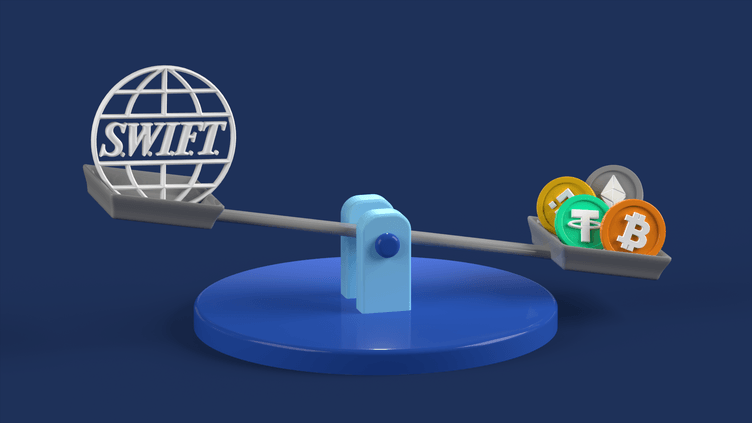SWIFT, the Society for Worldwide Interbank Financial Telecommunication, has been the foundation of global payments for decades. SWIFT’s messaging infrastructure facilitates the transfer of trillions of dollars between institutions on a daily basis. However, the financial world is currently grappling with a new inquiry: **Is it possible for crypto to replace SWIFT?** as digital currencies and blockchain networks become increasingly sophisticated.
This post will investigate the limitations of SWIFT, the ways in which crypto and blockchain are challenging the conventional cross-border payment system, and whether decentralized networks may be the future of global settlements.
SWIFT’s Issues
SWIFT is not without its shortcomings, despite its status as the industry standard for interbank messaging:
* **Delayed settlement times** — Cross-border payments can be delayed by several days, particularly when transferring funds across time zones and jurisdictions.
* **Exorbitant fees** — At each stage, numerous intermediary banks (“correspondent banking”) implement reductions.
* **Inadequate transparency** — Senders frequently lack knowledge regarding the timing of payment receipts or the associated fees.
* **Availability is restricted** — Sanctions can isolate countries from the network, and many regions continue to experience restricted access.
Despite SWIFT’s efforts to modernize (e.g., SWIFT gpi), critics contend that its architecture is inherently outdated, reliant on centralized intermediaries and legacy systems.
The Argument in Favor of Cryptocurrency: Efficiency, Transparency, and Speed
Cryptocurrency not only offers an alternative, but also a fundamentally distinct model. Rather than communicating about money, **blockchains** allow for direct money transfer, which offers several advantages:
✅ Settlement in Real Time
Transactions on networks such as Bitcoin, Ethereum, and Solana can be settled in minutes or seconds, eliminating the necessity for intermediary institutions.
✅ Permissionless and Borderless
National borders are not acknowledged by crypto networks. Global finance is accessible to anyone with an internet connection.
Cost-effectiveness
Crypto reduces both cost and complexity by automating processes through smart contracts and eliminating intermediaries.
Transparency
Real-time auditability is a feature of public blockchains, which provides insight into the status and history of transactions.
✅ Compatibility
The Interledger Protocol (ILP), Cosmos IBC, and Polkadot’s parachains facilitate the seamless transfer of value between various chains and systems.
🌍 Real-World Crypto Alternatives to SWIFT
Cross-border settlements are currently being addressed by numerous blockchain and crypto-based projects:
**Ripple (XRP)**: Pursues the replacement of correspondent banking with its On-Demand Liquidity (ODL) and RippleNet services.
* **Stellar (XLM)**: Concentrates on micropayments and remittances in emerging markets.
* **USDC & Stablecoins**: Dollar-backed tokens are becoming more prevalent for international transfers, as they provide price stability and rapidity.
* **CBDCs**: Central banks are conducting cross-border interoperability experiments, such as mBridge, which involves China, the United Arab Emirates, Thailand, and Hong Kong.
However, the situation is not as straightforward as it appears.
Cryptographic systems encounter substantial obstacles, regardless of their advantages:
Regulation
Governments are hesitant to relinquish control over financial infrastructure to decentralized systems. Unresolved challenges for public blockchains include KYC, AML, and sanctions compliance.
• Scalability
As demonstrated by Ethereum during bull markets, congestion and high fees may result from excessive network usage.
⚠️ Volatility
The volatility of cryptocurrency prices renders it unsuitable for numerous cross-border applications; however, stablecoins and CBDCs are assisting in addressing this issue.
Institutional Resistance
SWIFT is profoundly integrated into the operations of banks, which have legacy systems that are costly to replace. Blockchain is perceived by many as a complementary technology, rather than a substitute.
🔮 The Future: Integration or Replacement?
The most probable outcome is a **convergence**, rather than a **total replacement** of SWIFT:
* SWIFT is currently investigating the integration of blockchain technology and CBDC connectivity. Old and new systems are being bridged by crypto initiatives such as Ripple, which are collaborating with traditional banks and payment processors. Governments and institutions are investing in hybrid models that integrate blockchain innovation with regulatory compliance.
We may witness a world in which: by 2030.
* SWIFT employs blockchain infrastructure to facilitate secure, immediate settlement. The default instruments for cross-border transactions are stablecoins and CBDCs. Decentralized networks operate in conjunction with institutional rails, providing users with increased efficiency and choice.
Finally, it is important to note that cryptocurrency will not merely replace SWIFT; rather, it will redefine it.
The future of cross-border payments is **faster, cheaper, programmable, and more inclusive**, qualities that crypto and blockchain excel at delivering. While SWIFT may not disappear immediately, the direction is clear.
The genuine inquiry is not whether or not cryptocurrency will revolutionize global settlements; rather, it is the speed and scope of this transformation. The next iteration of finance is currently being constructed on-chain, whether through complete decentralization or integrated solutions.
**What are your thoughts? Is cooperation the path forward, or can crypto wholly replace SWIFT? Please express your opinions in the comments section below. **

Leave a Reply